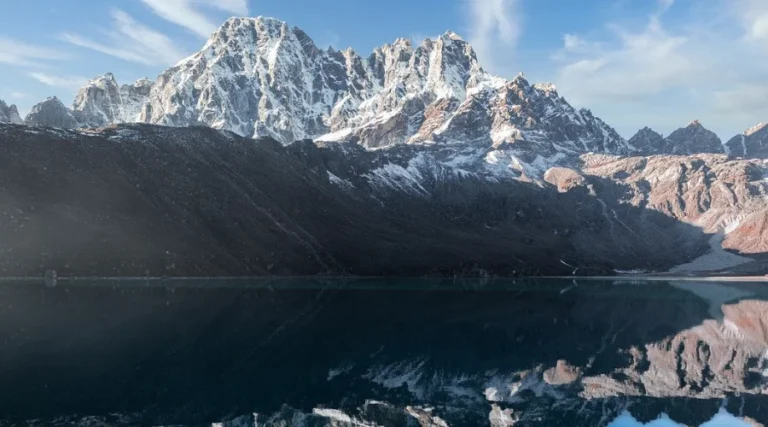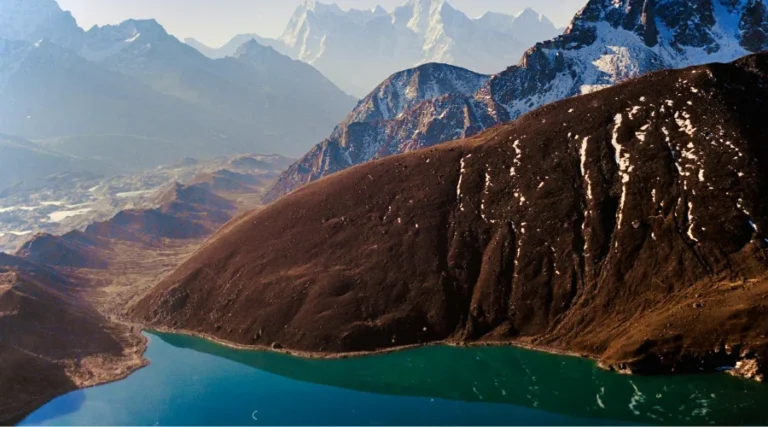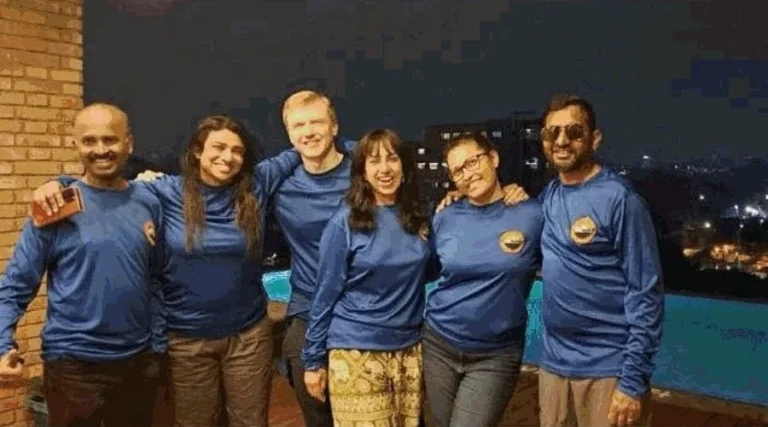Everest Base Camp Trek with Gokyo Chola Pass
-

Trip Duration 17 Days
-

Max, Altitude 5545m
-

Type Standard
-

Best Season Sept-Nov, March-May
-

Meals Included
-

Accommodation Included
-

Activity Trekking
-

Difficulty Strenuous
- Trek to the Everest Base Camp and feel close to the world’s highest mountain peak.
- Cross the exciting and geologically treacherous pass of Chola at 5,420 meters.
- Get a stunning view of Mount Everest and other giants like Lhotse, Ama Dablam, etc.
- Witness the six glorious glacial Lakes of Gokyo region Nepal.
- Get to learn about the Sherpas and their culture with meals and overnight accommodation in the local houses.
- Trek to monasteries that have a holy, peaceful atmosphere, including the Tengboche Monastery.
- Trek on the Ngozumpa Glacier, which is the largest glacier in Nepal.
- There are also beautiful prayer flags, mani walls and prayer wheels while on the trail.
- A closer look at the wildlife of the Himalayas and see yaks and other similar animals in their natural living place.
Everest Base Camp Trek with Gokyo Chola Pass is an impressive trek in the Everest region of Nepal. This trek links the main Everest Base Camp Trek with the fabulous Gokyo Valley and the rugged Cho La Pass.
The Chola Pass trek is a really wonderful opportunity to have spectacular views of some mountains like Everest, Lhotse, Nuptse, and Ama Dablam. It is equally suitable for those who desire adventure and, at the same time, have an interest in obtaining a vantage point to observe whimsical geographical formations.
The first step is by taking a flight to the stunning but tiny airport of Lukla. You will be treking through stunning Sherpa towns such as Namche Bazaar, Tengboche, and Dingboche. It is lined with prayer flags, monasteries and everybody you meet is the warm Sherpa people. It offers a firsthand view of the world’s highest mountain, which is known as Mount Everest.
Cho La Pass is the toughest phase of the trail, and that is why this pass is so popular. The trek asks for physical strength and requires cautious movement on slippery trails. On reaching Gokyo, you feel relieved and happy, but when you view the blue sea, it is like freshwater lakes surrounded by mountains. Gokyo Ri is one of the best locations in the region to have a view.
Chola Pass trek goes hand in hand with other treks in that it’s a perfect vacation for those who need more than the trek to Everest Base Camp. It is inclusive of aspects such as adventure, culture and even the natural landscapes in one travel package. The trail is tiring but the experience is worth the effort and the tiredness.
Overview of Everest Base Camp Trek With Chola Pass Gokyo
Everest Base Camp Trek with Gokyo Chola Pass is a special adventure, which integrates an exciting trekking trail and stunning moments.
On Chola Pass trek you travel on lesser known paths, providing a more tranquil and peaceful walk in the Everest area. It is an ideal option for those who want to step outside of the ordinary base camp journey.
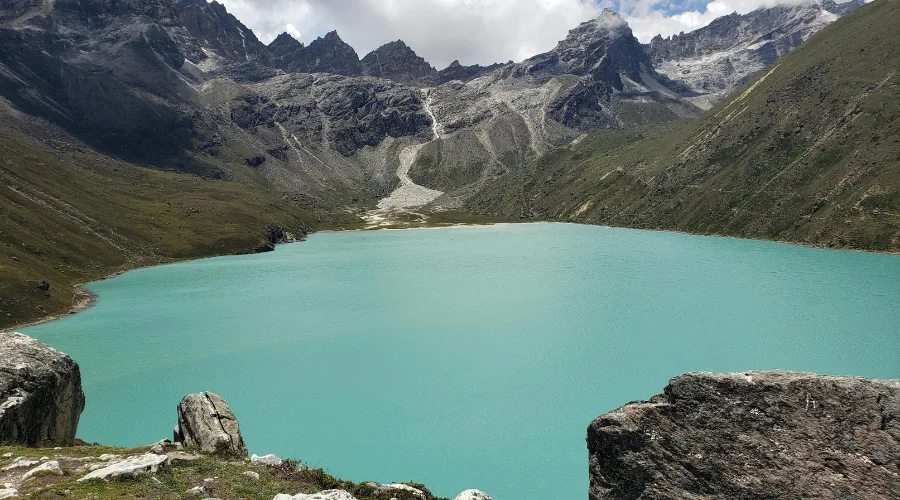
Everest Base Camp Trek with Gokyo Chola Pass follows remote valleys, frozen glaciers, and high mountain passes, and it evokes a feeling of real wilderness.
The dynamic terrain field has rocky slopes, glacial streams, and high cliffs. Trekkers frequently find the peace and quiet of these pristine regions a welcome escape from trafficked routes.
You’ll experience a variety of environments and conditions, so each day of the Gokyo lake Trek will be unique and interesting. From rugged trails to frozen ascents, it keeps the adventure real and exciting.
Everest Base Camp Trek with Gokyo Chola Pass, in turn, also allows greater intimacy with the beauty of the Himalayas, with the sight of natural wonder around every corner.
Short Itinerary
Itinerary of Everest Base Camp Trek with Gokyo Chola Pass
Once you land in Kathmandu, you sense the atmosphere of the colorful city. Its buzz is in the air, yet there’s peace as we be in peace and prepare for the journey to come.
Noticing the busy street, ancient temples, and colourful markets, Kathmandu comes across as really alive. We take the time to adjust to the new time zone and weather, knowing that the Everest Chola Pass trek will begin soon.
- 3 Star Hotel
- No Meal Included
The morning flight from Kathmandu to Lukla is an experience of exhilaration and anxiety as we fly over the terrain. The landing at Lukla’s short runway is thrilling. Once on the land, the trail brings us towards Phakding.
The trail from Lukla to Phakding is pleasant, with lush, green plants around us, but we begin to sense altitude sickness as we walk along the gentle route. Relief is felt when we reach Phakding at the end of the day.
- Local Guest House
- Breakfast, Lunch and Dinner Included
Today’s hike is more challenging. The pathway rises gently and winds its way through the thick forests, with the suspension bridges, and the spectacular mountain vistas.
The rise in terrain is greater, and the air becomes thin. We feel a little out of breath but keep a steady pace, eager to reach Namche Bazaar.
The excitement of reaching this Sherpa hub gives us a boost, even though the altitude starts to affect our energy levels.
- Local Guest House
- Breakfast, Lunch and Dinner Included
Namche Bazaar shall be our home for the day. After yesterday’s trek, our bodies need a break to adjust to the thinner air.
After a good breakfast, we will explore the heart of Namche. The Sherpa Museum which talks about local history and culture. It is time to learn about the brave Sherpas who have conquered these mountains for centuries.
Then we take off for the real magic. We shall hit the trail again for a short hike to Everest View Hotel. The view of the scene will surely make everyone speechless. Then we head back to Namche.
- Local Guest House
- Breakfast, Lunch and Dinner Included
After a well-rested day in Namche, we will hit the trail towards Tengboche. The trek from Namche to Tengboche will take us about 5 hours. The way will be full of outstanding mountain scenery.
Our destination is truly special: Tengboche. It has the largest monastery in the entire Khumbu region. And as a bonus, we will get an incredible view of Mount Amadablam. You will be staying at a cozy lodge in Tengboche.
- Local Guest House
- Breakfast, Lunch and Dinner Included
Get ready for another adventure! Today, we will start with a gentle downhill walk for about an hour until we cross a wooden bridge. After that, it is uphill as we make our way to Pangboche.
Hiking today is a steady climb through rhododendron forests and rocky paths. The way seems to be more arduous as we walk through alpine meadows.
We will stop for lunch in Somare, a place where the vegetation starts to thin out as we climb above 4000 meters.
Our final destination for the day is Dingboche. It is actually a cozy village at 4400 meters. We will spend the night in a comfortable lodge surrounded by beautiful mountain views.
- Local Guest House
- Breakfast, Lunch and Dinner Included
Day 7 is all about adjusting to the altitude yet again. We will take a challenging hike up Nagarjuna Hill, which is right above Dingboche. Once we reach the top, the mountain views are just magical!
After enjoying the scenery, we shall head back to Dingboche for lunch. The rest of the day is yours to explore the area or simply relax. It is your call! We’ll spend the night in Dingboche.
- Local Guest House
- Breakfast, Lunch and Dinner Included
The altitude begins to put a strain on us, we slow down and take regular breaks. The walk for the day is strenuous because there are steep sections and the constant wind brings a chill.
The trail starts off easy to Thukla. This is a good spot to rest your legs and grab something to eat, as there won’t be any other chances until we reach Lobuche. After Thukla, the path gets steeper.
We will climb up to Thukla Pass, where we will find a memorial honoring brave climbers who lost their lives chasing their Everest dreams. Once we make it to Lobuche, we will spend the night in a cozy lodge, taking in the incredible mountain views.
- Local Guest House
- Breakfast, Lunch and Dinner Included
Day 9 is going to be incredible. Today, we will reach a major milestone: Gorakshep. This is our last chance to rest before our big adventure. We will drop our bags at the hotel, have lunch, and then rush to the journey of a lifetime – Everest Base Camp.
Standing at the foot of the world’s tallest mountain is a dream come true for many, and today, that dream becomes reality. After enjoying this very moment, we will head back to Gorakshep for a well-deserved night’s rest. This is one day we will never forget.
- Local Guest House
- Breakfast, Lunch and Dinner Included
The early morning hike to Kalapatthar feels surreal. It’s crisp here, but the vista of Everest itself and the other peaks in the area is breathtaking.
Since we cannot see the perfect view of Everest from the base camp we hike up to Kala Pathhar.
In these altitude conditions, each step is more difficult, and the thin air, because of the difficulties it causes while breathing, makes it tough.
After we have soaked in the scenery we lower ourselves to Zongla. Dwell long and hard but the Kalapatthar will feel a sense of triumph to keep us moving.
- Local Guest House
- Breakfast, Lunch and Dinner Included
Day 11 will be a tough one. We will climb high, through snow and ice, to cross the challenging Cho La Pass. It is actually a big day!
Once we conquer the pass, we will head downhill to Dragnak. Dragnak is a peaceful village with very few stone houses. This is our base for tackling Cho La Pass.
We will spend the night in a simple guesthouse there, getting ready for the next adventure.
- Local Guest House
- Breakfast, Lunch and Dinner Included
With the arduous Cho La Pass behind us, today’s walk to Gokyo already seems like a day to relax. The trail is a combination of rugged paths and flats, which allows a temporary rest.
The views of Gokyo Lake are spectacular, and with every step closer to the village, peace and quietude are there to restore us. The thin air continues to challenge us, but Gokyo feels welcoming after the hard work of the previous days.
- Local Guest House
- Breakfast, Lunch and Dinner Included
This day is going to be an epic adventure. We shall start our trek today with a challenging climb up to Gokyo Ri. Once at the top, we shall be surrounded by thrilling views of four massive mountains – Everest, Lhotse, Makalu, and Cho Oyu.
It is a sight you won’t forget. After taking it all in, we will explore the great Gokyo Lakes before heading back down to Dole. It is a long day, but the experiences will be magical.
- Local Guest House
- Breakfast, Lunch and Dinner Included
The return journey down to Namche Bazaar takes the form of a relief after several days of uphill trekking. The trail is somewhat easy, but the rutted terrain demands concentration.
We feel a sense of accomplishment as we make our way down, with the scenery changing as we descend. The arrival at Namche gives us well-earned rest .
- Local Guest House
- Breakfast, Lunch and Dinner Included
The hike to Lukla today is a continuous downhill pathway through forest and small settlements. On approaching Lukla, we think about the extraordinary voyage that has taken us there.
The destination itself feels like a prize, and we look forward to a good sleep before returning home by plane.
- Local Guest House
- Breakfast, Lunch and Dinner Included
The flight from Lukla to Kathmandu is a short but spectacular one with incredible scenery from the sky. Back in Kathmandu, we experience a sense of both exhaustion and accomplishment.
The Cho La Pass journey has been difficult, but the experiences and the memories are more than worth any discomfort. There is a feeling of relief to go back to the city again.
- 3 Star Hotel in Kathmandu
- Breakfast and Dinner Included
This is it, your last day in Nepal. It’s time to say goodbye, but we hope we’ll meet again! Our representative will escort you to the airport three hours before the scheduled flight.
Flight from Kathmandu/ Manthali to Lukla
The weather conditions in the mountain region of Nepal can change rapidly and aviation schedules are not as reliable as you might expect. The flight between Ramechhap/Manthali and Lukla is frequently delayed and maybe cancelled for the day or several days in succession.
In the event your flight is cancelled we will either rebook your flight for the following day. It is recommended to apportion one or two extra days in case your flight gets cancelled and you are in short of scheduled time.
Price includes
- Kathmandu Airport – Hotel – Airport transfer by Private vehicle
- Three Meals (Breakfast, Lunch and Dinner) during the trek
- Tea and Coffee during the trek
- Twin Sharing Accommodation at Kathmandu at 3 star hotel with breakfast
- Twin sharing accommodation during the trek
- National Park Entry Fee, Local Government Entry fee
- Domestic Flight from Kathmandu/Ramechhap to Lukla and Return
- 1 Experienced guide for the group of 2 to 10 and assistant guide for a group above 10
- One porter assigned for two people to carry luggage
- Our Staff’s daily meal, wage, equipment, insurance and allowances
- First aid kit with high-altitude medicines
- Duffel bag and Sleeping bag (Must be returned after completion of the trek)
- Trek completion certificate (Upon request)
- Our Service Charges
Price Excludes
- International airfare, Nepal Visa and travel insurance
- Meals in Kathmandu except breakfast
- Extra night accommodation in Kathmandu ( early arrival or flight cancellation etc)
- Personal expenses such as shopping, Laundry, Internet, Phone call etc
- Drinking water, cold drinks and alcohol drinks
- Gratuities for staff
Have any Questions? Check out FAQ'S
Trip Essential Information
How hard is Cho La Pass?
The Chola Pass difficulty is high, requiring physical and mental endurance. The Cho La Pass consists of steep climbs, rocky ground, high altitude all of which make it suitable route for the experienced trekker. Trekkers need to walk for 6 to 8 hours daily, often on uneven and rugged terrain.
Crossing Cho La Pass is the most challenging section of the trek. The path is also very steep and is covered with snow, which is common during winter, so it is slippery and dangerous. The trail contains narrow ridge alignments, loose rocks, and areas that demand attention in terms of foot placement.
The combination of trekking poles and crampons is useful in these adverse conditions. The high altitude is another major challenge. The summit trek is at an altitude exceeding 5,420 m, where oxygen concentration is very low. This can result in altitude sickness if trekkers do not acclimatize to altitude adequately.
Proper rest days, adequate hydration, and incremental ascent are critical to mitigate risk. Weather conditions can also add difficulty. Sharp tempers, such as sudden changes with severe winds and snow, are a way of life in this area.
To maintain warm behaviours, the right clothing is required for cold temperatures, especially at night. It is important for trekkers to be equipped for all of these factors in order to successfully complete one of these challenging treks.
Food During Everest Base Camp Cho La Pass
The food on Nepal’s Everest Base Camp Chola Pass Gokyo Trek is, in general, simple foods that nourish the body, including dal bhat (lentil soup and rice), noodles, soups, and boiled potatoes.
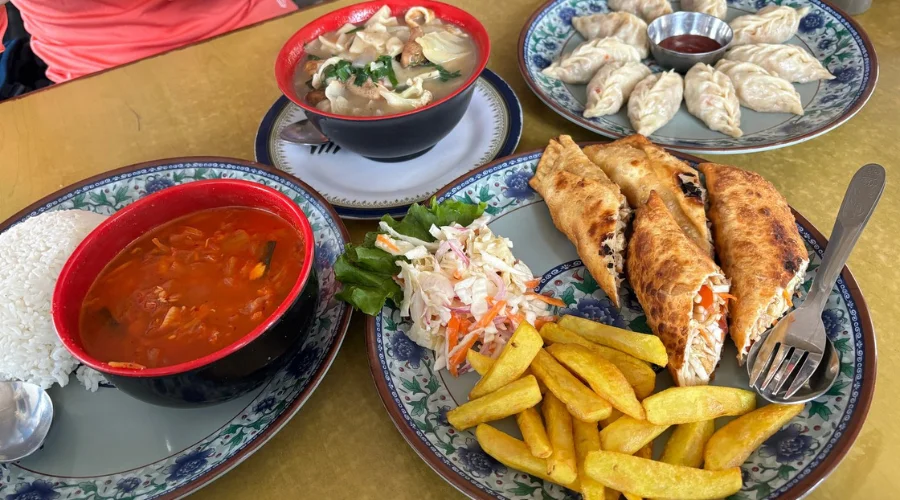
Breakfast includes oatmeal, eggs or toast with tea or coffee. At high altitudes, choices come down to a reduced number of food options and a greater reliance on energy-dense food in order to power long and arduous hikes.
The food is hot and filling, easing you back in to recover from the crispness and exhaustion of hiking. Consuming these meals gives an immediate boost, though you might feel cravings for variety. Adequate eating is essential for withstanding the rigours of the terrain and altitude.
Everest Base Camp Chola Pass Trek Cost
The cost of Everest Base Camp Chola Pass Gokyo Trek is $1,650 per person. However, it can be adjusted according to group size. In groups larger than one, the rate is reduced, which makes it affordable for friends or family groups.
The services at this cost of Everest Base Camp Chola Pass trek include permits, lodging, meals, a professional guide, a porter, and transportation to provide a very convenient, worry-free experience. However, personal expenses, travel insurance, and tip-offs are excluded.
Remember to budget for extra things such as snacks, hot showers and electronics charging when it’s high up in the mountains. The complex terrain, such as rocky trails, glaciers, and snow routes themselves, provide the thrill of adventure.
But it needs to be prepared well. Hiring experienced guides and porters through our package ensures your safety and comfort in these remote areas.
Our package aims at providing best experience by means of combining beautiful landscapes, cultural activities, and a well-organized trekking adventure. It’s a cost-effective option for this unforgettable adventure.
Chola Pass Trek Distance
The Everest Base Camp Trek distance with Gokyo Chola Pass is about 130 km (81 miles) round trip. The trail is a mix of steep climbs, rocky, glacial crossings, and narrow ridges, which are both challenging but rewarding. The distance is divided into manageable sections to allow proper acclimatization.
The Everest Gokyo Lake route changes from the well-trodden trails to icy parts over the Cho La Pass and moraine-rich land near Gokyo. Daily hikes vary between 10 and 15 km according to altitude and trail disruption.
The presence of rocky terrain, high passes, and long daytime makes this hike mentally and physically demanding.
Permits for Everest Base Camp Chola Pass Gokyo Trek
The Sagarmatha National Park Entry Permit and the Khumbu Pasang Lhamu Rural Municipality Permit are required to trek in Everest and Gokyo region Nepal.
The Sagarmatha National Park Entry Permit is a requirement with a cost of NPR 3,000 (amount for foreigners) and permission to explore the national park’s trails.
Khumbu Pasang Lhamu Rural Municipality Permit is NPR 2,000, and it is compulsory for the Khumbu region. Trekkers experience crossing villages, suspension bridges, and rugged paths covered by this permit. Both permits can be obtained in Kathmandu or Monjo.
Make sure all permits are valid since checkpoints throughout the route demand strict adherence. These papers are essential for legal and trouble-free hiking in this challenging area.
Typical day in Gokyo Cho La Pass Trek
The day starts early, around 6: 00 AM, accompanied by a warm sip of tea or coffee. Following breakfast (typically porridge, eggs, or toast) you gather your equipment and set off at 7:30 AM. The trail is generally characterized by steep rises, stone steps, and uneven surfaces traversing forests or open ridges. The cool air, and the direct visibility, makes it the best time for continuous progress.
You stop for lunch around 12:00 PM at a teahouse or lodge. There is enough food like dal bhat or noodles, which provide enough energy they need during the afternoon hike. Following a brief pause, the trip goes on rough landscapes, suspension bridges, or glacial moraine. By midday, the temperature can be extremely hot, and altitude gain can slow your progression, requiring repeated rests.
By 4: 00 PM or 6:00 PM, you arrive at the teahouse for the night. The day is finished by relaxing, having a hot meal and getting ready for the next day. The cold weather set in quickly, especially at higher altitude. Trekkers usually gather up in the dining room to keep warm, read, or tell tales. By 8:00 PM, most trekkers go to bed, saving energy to make it to the next difficult day.
Best time for Everest Gokyo Chola Pass trek
The best season of the Everest Base Camp Chola Pass Gokyo Trek is spring (March to May) and autumn (September to November). In spring, temperatures are mild, from -5°C to 15°C, and the trails are a beautiful sight with rhododendrons blooming. The landscape is stable, snow is less unlikely to block the Cho La Pass.
The autumn weather is cold and bright, with a beautiful mountainous scene and comfortable trekking environment. Daytime temperatures are about 10°C, but at night, they can be as low as -10°C. The trails are dry and thus less risky to walk even on steep slopes and glacial passages.
Drinking Water during the Chola Pass Trek Route
Water for drinking on the Everest Base Camp Chola Pass Gokyo Trek is provided but must be properly treated. Streams, teahouses, and lodges supply drinking water, but drinking water should not be drunk without treatment in view of possible contamination. Use water purification tablets, filters, or UV purifiers to guarantee safety.
Where there are higher altitudes, water sources may freeze, and boiling water becomes the only reliable way to disinfect. Bottled water is available but very expensive, costing NPR 400 per litre in remote areas. Hydration plays a major role in avoiding altitude sickness since the cold conditions and the strain on the body can rapidly result in dehydration.
Everest Base Camp Trek Insurance
Insurance for the Everest Base Camp Gokyo Trek is the right thing to do because of the risks of high altitude and difficult terrain. Confirm that your policy includes coverage for trekking up to 5000 meters, emergency helicopter evacuation, and medical care.
Due to the narrowness of the rocky trails, the icy Cho La Pass, and the remoteness of the places, rapid medical support can be challenging unless there is adequate coverage.
Policies should also consider trip delays or cancellations due to unforeseen weather conditions. Altitude sickness, injuries resulting from steep approaches or falls on icy glacier passages are some of the risks.
Good coverage gives a sense of peace of mind and financial security when facing this demanding extreme experience.
Accommodation during Everest Chola Pass trek
Trekking on Everest Base Camp Chola Pass Gokyo Trek offers a variety of accommodations, from simple teahouses to basic lodges. In lower areas like Namche Bazaar, there are hotel rooms with beds and blankets.
As you ascend to higher altitudes, accommodation worsens with altitude, particularly in highland villages such as Dingboche and Lobuche.
Rooms are small and often shared, with limited heating. Basic provision is expected, such as communal bathrooms and icy cold baths, because fresh water may not be available at higher locations.
The terrain is remote, so amenities are scarce. The farther you get, the more rural the lodgings become, yet they provide warmth and protection from exhausting days.
WiFi, Electricity and Communication in Everest
WiFi, power, and communication are limited, but work in some places along the Everest Base Camp Chola Pass Gokyo Trek. WiFi access is quite common in teahouses and lodges at low altitudes, like Namche Bazaar and Lukla, but it is often slow and patchy.
Expect to pay around NPR 500–1,000 per hour for internet access. The signal gets weaker as you go higher, and the internet becomes scarce.
Electric power is sometimes present but is also low power with solar panels or generators used to provide it. Even with devices, charging fees may apply, particularly in areas above Dingboche where the electricity supply can be unpredictable.
For communication, mobile reception is only available in some areas like Namche and Dingboche, but it is spotty beyond that. Satellite phones are an option in case of emergency; however, it is costly to rent. Connectivity due to rough terrain and altitude presents a challenge.
Frequently Asked Questions (FAQ)
This trek is considered strenuous due to high altitudes, steep ascents, and technical sections like the Cho La Pass. Trekking time may vary and there are normally 6 to 8 hours, depending on the terrain and acclimatization.
The ideal seasons are spring (March to May) and autumn (September to November) for Everest Base Camp Trek with Gokyo Chola Pass. During these times, the weather is calm, and the trails are open with unobstructed views and temperatures at a moderate level.
Two essential permits are needed for Everest Base Camp Trek with Gokyo Chola Pass. The Sagarmatha National Park Entry Permit and the Khumbu Pasang Lhamu Rural Municipality Permit. These permits are compulsory for entrance into the Khumbu area.
The trek is normally 18 days long, with acclimatization days and periods of rest included. This time also enables trekkers to acclimatize at the elevation and to take the trip without hassle.
The Everest Base Camp Chola Pass Gokyo Trek is priced at $1,650 per person on our website. This cost may vary based on group size and specific itinerary adjustments.
Trekking provides an overall maximum elevation of 5,420 m at the Cho La Pass. At this high-altitude acclimatization is necessary to avoid altitude sickness.
Accommodation ranges from basic teahouses to simple lodges. At higher altitudes, accommodation becomes more basic, with common and restricted services. Carrying a sleeping bag is also advisable for greater comfort.
WiFi is available in some areas like Namche Bazaar and Lukla but can be slow and unreliable. Electricity can be drawn in some areas, mostly by solar panels or generators, and charging points will be scarce. It’s recommended that extra power banks be carried.
Items to consider are a sturdy pair of trekking boots, a variety of clothing for changing temperatures, a sleeping bag, a water treatment system, a first aid package and an excellent quality backpack.
Carrying enough cash is also crucial, as access to ATMs is limited to remote locations.
- Instant Confirmation
- Free to customize
- Support anytime
© 2025 - Himalayan Trekking and Tours (P) Ltd. All Rights Reserved.












